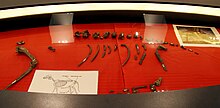| Lycaon sekowei Temporal range: Early Pleistocene
| |
|---|---|

| |
| Fossil of Lycaon sekowei, a possible ancestor of the African wild dog | |
| Scientific classification | |
| Domain: | Eukaryota |
| Kingdom: | Animalia |
| Phylum: | Chordata |
| Class: | Mammalia |
| Order: | Carnivora |
| Family: | Canidae |
| Genus: | Lycaon |
| Species: | †L. sekowei
|
| Binomial name | |
| †Lycaon sekowei Hartstone-Rose et al., 2010
| |
Lycaon sekowei is an extinct canid species from southern Africa that lived during the early Pleistocene epoch, dating from 2 to 1 million years ago.[1][2]
Hartstone-Rose and colleagues claimed that L. sekowei was a hypercarnivore just like the modern African wild dog (L. pictus), though its front paws were not as specialized for running. They also proposed that L. sekowei was the ancestor of the wild-dog lineage based on dental morphology similar to that of L. pictus and the European Lycaon-like canids.[2] In 2013, however, Madurell-Malapeira and colleagues considered the hypothesis that the genus Lycaon may have originated from Eurasia and dispersed into Africa by 2 million years ago would be more likely, given the substantial variability of dental characters and the relatively scarce African record of Lycaon-like canids.[3]
- ^ Fourvel, Jean-Baptiste; Frerebeau, Nicolas (2023). "A new canid species (Carnivora: Canidae) from the Plio-Pleistocene hominin-bearing site of Kromdraai (Cradle of Humankind, Gauteng, SouthAfrica)". Paläontologische Zeitschrift. 97: 163–177. doi:10.1007/s12542-022-00628-4. S2CID 251042977.
- ^ a b Hartstone-Rose, A.; Werdelin, L.; De Ruiter, D. J.; Berger, L. R.; Churchill, S. E. (2010). "The Plio-Pleistocene Ancestor of Wild Dogs, Lycaon sekowei n. sp". Journal of Paleontology. 84 (2): 299–308. doi:10.1666/09-124.1. S2CID 85585759.
- ^ Madurell-Malapeira, Joan; Rook, Lorenzo; Martínez-Navarro, Bienvenido; Alba, David M.; Aurell-Garrido, Josep; Moyà-solà, Salvador (2013). "The latest European painted dog". Journal of Vertebrate Paleontology. 33 (5): 1244–1249. doi:10.1080/02724634.2013.770402. hdl:2158/816314.